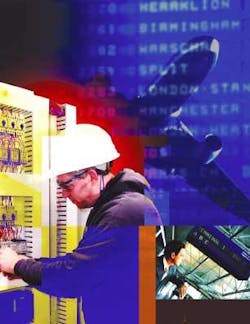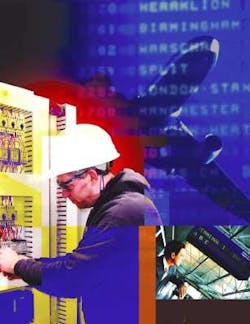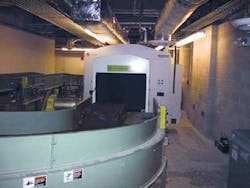Keeping the bits, and the passengers, flying
Manchester (NH) Airport is in the minority among U.S. airports in that its passenger load has grown steadily in the past couple of years. The airport set passenger and cargo activity records in 2002, with 3,363,243 passengers (a 4% increase) and more than 181 million pounds of cargo (an increase of almost 9%) making their way through the facility. "Manchester is fortunate to be among a very select group of airports nationwide experiencing passenger growth," according to airport director Kevin Dillon.
While its increasing passenger and cargo loads make it unlike most, Manchester was exactly like all other U.S. airports in that it had until December 31, 2002 to comply with the federal mandate to screen 100% of checked baggage for explosives. Screening every bag required the installation of elaborate and sizable explosive-detection systems (EDSs) manufactured by L-3 Communications (www.l-3com.com).
In all, six EDS machines were installed at Manchester Airport, and Interstate Electrical (www.interstateelectrical) of N. Billerica, MA, won the bid for the electrical-systems portion of the EDS job; the voice and data communications systems work was one portion of that electrical contract.
Terminal expansion project
While the EDS project was going on, the airport was also in the early stages of a passenger-terminal expansion. The 228,000-square-foot terminal is being expanded by 70,000 square feet. The addition will include four new jet gates, ticket counters, baggage claim, and concession areas. Started last October, its anticipated completion date is January 2004. Harvey Construction Corp. (www.harveyconstruction.com) of Manchester is the construction manager for the project.
The EDS installation was part of the overall expansion project. Harvey's project manager Rob King explains, "During the interview process for the terminal expansion, the baggage-screening project was added. It became more work than anybody anticipated at the outset.
"What makes Manchester unique, and what created a challenge for everyone, was the airport director decided early on that the system would be fully automated, with no disruption to passengers and very little disruption to the airlines involved."
In many airports across the country, EDS machines are visible and passengers can see baggage being loaded onto, and screened within, these systems. Such is not the case at Manchester Airport. Dillon's goal was to ensure the screening system provided the highest level of security while not impacting customer service; that meant keeping it out of the lobby and gate areas. Additionally, the screening system was to be completely automated through a series of conveyors. When a passenger checks baggage, the ticket agent places the baggage onto a conveyor belt behind the ticket desk, and that is the last personal handling the bag receives before the EDS screens it. A system of conveyors takes the baggage from the ticket counter to the EDS machine. From there, bags that are considered suspect follow a conveyor system to an area where Transportation Security Administration agents conduct additional screening, while bags that are not suspect are carried by conveyor to an airline's loading area.
Work scopes defined
"Some work began in September, and the project went into full function October 1," says Joe Ray, RCDD, project manager for Interstate Network Systems, a unit of Interstate Electrical Services.
"Interstate did a lot of the basic design work," comments Harvey's King. "The electrical engineer of record did the power and lighting designs, and Interstate designed much of the rest, including communications wiring."
"We sat down with each airline and developed a scope of work," says Interstate's Ray. "Airport traffic had grown substantially, and new airlines had begun servicing the airport over the years. Because of the activity increases, tracing some of the circuits was difficult. We determined that meeting with each airline to establish a schedule and framework was appropriate and necessary."
Deploying the systems while ensuring minimal disruption to the airlines proved significantly challenging, because each airline's ticketing and office operations had to be moved when its EDS was installed.
"Airline office moves had to take place after a day's final flight arrived, and before check-in began for the next day's first flight—which usually meant between 11 P.M. and 4 A.M.," explains Michelle Paris, superintendent of the voice and data communications portion of the project.
Each such move had to happen twice for every airline—once preceding and once following its EDS installation. For the two airlines that will occupy the yet-to-be-built expansion of the terminal, however, operations remain housed in trailers that serve as temporary offices.
Ray explains that the airport's policy was to replace each airline's cabling infrastructure with like-kind products. Airlines would be responsible for the difference in cost if they chose to upgrade. "Most of the airlines were running Category 5e, and this project was unplanned for all of them. Most of them didn't have the budget to upgrade, so they stayed with 5e."
According to Ray, most airlines agreed to use the brand names for which Interstate is a certified installer, thereby obtaining an extended warranty on the system. But one airline demanded a specific brand of connecting hardware. "They are the customers," he says, "and they had the right to specify brands if they chose to. It was our job to accommodate them, and that's what we did."
Installation challenges, opportunities
The airport's physical layout presented several challenges to the communications-wiring installation crews. Airlines update the flight-information displays (FIDs), which are spread throughout the terminal, from their offices. Additionally, each ticket counter has a nine-inch FID monitor. So, the ticket counters and airline offices—the workstations that were in such flux during this EDS installation—had to remain wired to the central FID system.
null
Each airline serving Manchester Airport offers curbside check-in, and each curbside location requires the same cabling set-up as the in-building ticket counter. "It is just about a 500-foot run from the airline office to the curb," explains Interstate's Paris. "The cabling runs underground. Most airlines chose to use fiber cable because of the loss that comes with a 500-foot run."
Cable tray runs overhead in the area of the airport known as the "tugway," where baggage is transported between the aircraft and the building. The existing tray was heavily occupied, requiring the installation of new tray to some parts of the airport. Currently, just a few cables occupy that tray, and those cables are serving temporary office space. So, the airport has plenty of pathways in which to place the infrastructure for many future upgrades.
One enhancement that was made to the facility's pathways was installing 2-inch conduits where 1-inch conduits had previously fed ticket counters. "The 1-inch conduits were quite full," says Interstate's Ray. "The temporary moves gave us the chance to place parallel 2-inch conduits to feed each ticket counter. If the counters ever need more capacity, they will have it."
Earning multiple contracts
As a full-service contractor, Interstate became something of a jack-of-all trades on this project. It began with the initial contract bidding. Says Harvey's King, "We asked for proposals based on unit pricing. There were four bidders for the electrical subcontract, and the job was awarded based on an hourly rate. Interstate's competitors, for the most part, had to go to third parties for the communications work. There is no question that Interstate's ability to do that work itself gave it a competitive advantage in the bidding phase."
So, Interstate got onto the jobsite as the electrical and communications cabling contractor, working directly for the construction-management firm. Interstate also secured contracts for wiring jobs from other trades on the project. For example, it worked as a sub to the provider of the EDS machines, installing the systems' power and control wiring. Similarly, the provider of the conveyor system hired Interstate to take care of those systems' power and control wiring. The company also got some work running wiring for door-access systems.
"One of the benefits of having Interstate was that they did an excellent job staffing the project," King says. "There was never a manpower shortage. They did a fantastic job manning and supervising the job."
"As our involvement in the overall job grew, I made the case for more supervisors on the site," says Ray. "We ended up with four superintendents on the job—Michelle overseeing the airlines' voice and data systems, another overseeing the work on the EDS machines, a third for the conveyor systems, and an overall supervisor for all of our operations."
He emphasizes that some individuals' diverse capabilities paid dividends as well. "Michelle is one of three Interstate employees who are licensed electricians and BICSI-certified cabling technicians. That helped a lot because if an airline had a power or communications problem, or both, she could take care of it right away without having to call somebody out from the office."
At the time this article was being researched, bidding was still underway for many of the contracts for the 70,000-square-foot terminal expansion. The expansion will include two EDS machines and the infrastructure for two airlines, which will finally move from their temporary trailer offices to permanent space.
Patrick McLaughlin is chief editor of Cabling Installation & Maintenance.


